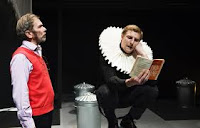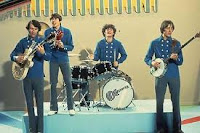 Stuart Davis: Art & Theory
Stuart Davis: Art & Theoryan exhibition at the Pierpont Morgan Library, New York
through 15 December 2002
Stuart Davis: Art and Theory, 1920-31
by Diane Kelder
Pierpont Morgan Library, $7.95 ISBN 0875981380
NOTE: Searching my floppy files today, I stopped to reread this article, which was published in the TLS ten years ago. It brought back a very pleasant memory of the exhibition at the Morgan, which I came across because I liked to use their cloak room as a left luggage facility while passing between the airports and Grand Central Station (whose storage was closed at the time, for security concerns) and also because their cafe was so nice. I hadn't really appreciated Stuart Davis before, and this exhibition was one of those excellent ones that shows you something in a way you've never seen it, nor thought about it, before.
One of the effects of the modern art explosion that came from America just after the Second World War has been to overshadow the work of artists who bridge the gap in the tradition between the realists, like Thomas Eakins or John Sloan, at the beginning of the Twentieth Century, and the abstract expressionists and pop artists from that century’s middle. Stuart Davis was one of the most important of those artists, and Diane Kelder, in her sharply written monograph which accompanied a small but revealing exhibition of his work at the Pierpont Morgan Library in New York, has taken a large step toward placing Davis firmly in the context of a continuum in modern American art.
Davis was a realist prodigy,
 not yet 21, when five of his watercolours were displayed in 1913 at the International Exhibition of Modern Art, at the 69th Regiment’s Armory, the famed Armory Show which introduced America to European modern art. He came by his talent naturally. His mother was a sculptor, his father an artist who served as art director of a Philadelphia newspaper, where many of the group of realist painters known as "The Eight" supported themselves doing illustrations.
not yet 21, when five of his watercolours were displayed in 1913 at the International Exhibition of Modern Art, at the 69th Regiment’s Armory, the famed Armory Show which introduced America to European modern art. He came by his talent naturally. His mother was a sculptor, his father an artist who served as art director of a Philadelphia newspaper, where many of the group of realist painters known as "The Eight" supported themselves doing illustrations.One of them, John Sloan, later served as art director of the influential socialist magazine, ‘The Masses’; he bought illustrations from the teenaged Davis, who was already in New York studying with the best-known of the group, Robert Henri, whose work led to their being re-named ‘The Ashcan School’. They brought a gritty but vivid new realism to the straining loftiness of American art, a concern with the everyday life of cities, particularly working class pleasures and bohemian life ‘downtown’. They loved the music halls and boxing rings, and the young Davis. a piano player himself, haunted the clubs in the black sections of Newark and Hoboken, seeking out the music which, brought from the south to the urban centres of the north evolved into jazz.
The music makes a interesting parallel for the art, because what Kelder’s penetrating study shows is how Davis, like so many other American artists, whose view of the world was already being changed by the heady enticements of the new modern popular culture, had his idea of art transformed at the Armory show. changed the way they saw art.
 Kelder shows how Davis absorbed and adapted the influences of European modernism, turning them into something different, unique, and particularly American. In the process of seeking out his own artistic amalgam, Davis in many ways laid the foundation for much of what followed, and in fact might lay claim to being the hidden father of Pop Art.
Kelder shows how Davis absorbed and adapted the influences of European modernism, turning them into something different, unique, and particularly American. In the process of seeking out his own artistic amalgam, Davis in many ways laid the foundation for much of what followed, and in fact might lay claim to being the hidden father of Pop Art.For Davis, the link with music was particularly clear. At the Armory he was dazzled by the Fauvists’ use of non-realistic colour to make emotional impact, something for which he had been striving in his own work. "It gave me the same kind of excitement I got from the numerical precisions of Negro piano players…and I resolved I would quite definitely have to become a "modern" artist’, he recalled in 1945.
Of all the artists on display at the Armory, Van Gogh remained the biggest influence. In 1919 Davis painted a self-portrait which at once used bright colours, a yellow face with red lips, a shining blue shirt, and a deep red background, to pay hommage to Van Gogh while already hinting at a move to a style more abstract. That was because Davis was also, like his contemporaries, profoundly affected by Cubism, the other shocking highlight of the Armory show. Although the impact for Davis was immediate, in his case the gestation of the style was slow.
 As early as 1917, in his painting ‘Garage’, Davis was blending a working-class, realist subject with the unreal colours of a Fauvist palette, and experimenting with planes which overlapped. He summered among the fishermen of Gloucester, Massachusetts, and his 1918 work, ‘Multiple Views’ (below right) is just what its title implies, an attempt to paint various scenes of life in that port (including the recurring garage) simultaneously. The mix of styles results in a painting with a curious feel more medieval than modern.
As early as 1917, in his painting ‘Garage’, Davis was blending a working-class, realist subject with the unreal colours of a Fauvist palette, and experimenting with planes which overlapped. He summered among the fishermen of Gloucester, Massachusetts, and his 1918 work, ‘Multiple Views’ (below right) is just what its title implies, an attempt to paint various scenes of life in that port (including the recurring garage) simultaneously. The mix of styles results in a painting with a curious feel more medieval than modern.By integrating objects into planes, Davis was able to create a vibrant sort of cubism, and the nature of the objects he chose, beyond his self-portrait, with echoes of his populist realism, let him indulge that Fauvist palette that had so excited him.
 Bottles of Odol mouthwash, Lucky Strike cigarette packs, Bull Durham tobacco and Zig-Zag papers, even the literary magazine The Dial feature in his paintings, deconstructed decades before deconstruction. The interaction with poetry was particularly strong, especially the influence of William Carlos Williams. It's instructive to compare Williams' influence on Davis with, say, his effect on Charles Demuth, whose work shares similar concerns with integrating the planes of cubism into realistic settings, but in Demuth's case becomes refined into powerful and bleak industrial landscapes.
Bottles of Odol mouthwash, Lucky Strike cigarette packs, Bull Durham tobacco and Zig-Zag papers, even the literary magazine The Dial feature in his paintings, deconstructed decades before deconstruction. The interaction with poetry was particularly strong, especially the influence of William Carlos Williams. It's instructive to compare Williams' influence on Davis with, say, his effect on Charles Demuth, whose work shares similar concerns with integrating the planes of cubism into realistic settings, but in Demuth's case becomes refined into powerful and bleak industrial landscapes.Williams used a Davis painting for the frontspiece of ‘Kora In Hell’ and found in Davis’
 work the suggestion ‘of development of word against word, without any impediments of story, poetic beauty, or anything at all except word clash and sequence’. Words formed the basis of a mural Davis painted for Gar Sparks’ Nut Shop, an infamous Newark bar.
work the suggestion ‘of development of word against word, without any impediments of story, poetic beauty, or anything at all except word clash and sequence’. Words formed the basis of a mural Davis painted for Gar Sparks’ Nut Shop, an infamous Newark bar.Davis’ own cubist experiments became refined in the ‘Egg Beater’ series of 1927-28 (below right) Here he nailed an electric fan, rubber glove, and egg beater to a table, and produced an extraordinary sequence of works dealing with the shapes and spatial relationships of the objects. In an early watercolour collage, Davis had added the letters ITLKSEZ: ‘it looks easy’…but the final part of Kelder’s study reveals that his artistic growth was anything but. Throughout his life, Davis kept notebooks, into which he entered, alongside sketches and experiments, his own thoughts on artistic theory and practice. Seeing the pages on exhibition, or reading them in Kelder’s study,
 one is struck with the single-minded aggression with which Davis pursued modernism, was entranced with the possibilities of a new way of seeing, and a better way of transforming that sight into art. Kelder has done a service not just to Davis, but to an entire era in American art by showing how this was done.
one is struck with the single-minded aggression with which Davis pursued modernism, was entranced with the possibilities of a new way of seeing, and a better way of transforming that sight into art. Kelder has done a service not just to Davis, but to an entire era in American art by showing how this was done.Note: This essay also appears at Untitled: Perspectives, my extremely irregular blog about art....










